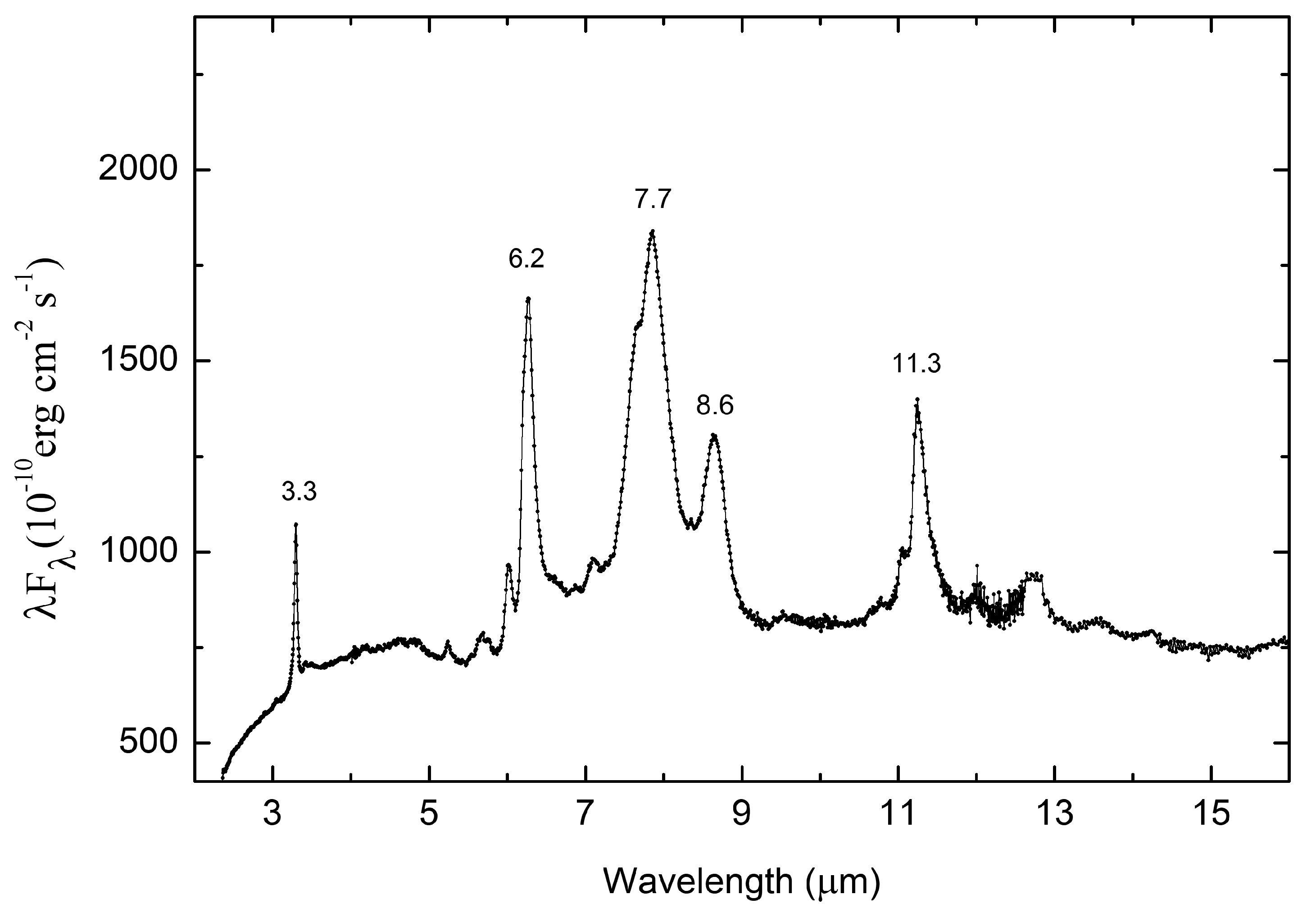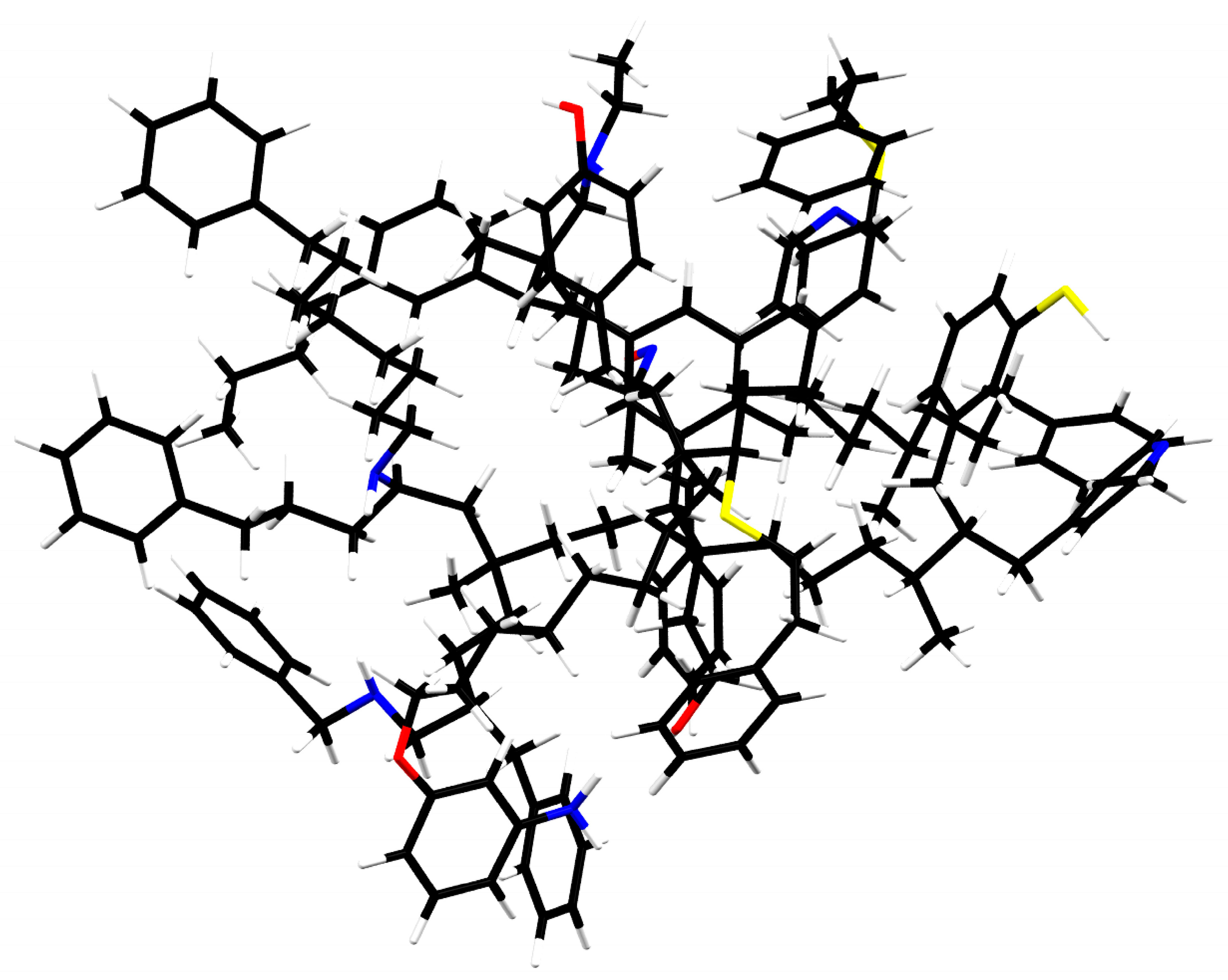Chemical Synthesis in the Circumstellar Environment
Abstract
:1. Introduction
2. Discovery of Proto-Planetary Nebulae
3. Confusion Between Planetary Nebulae and Other Objects
4. Synthesis of Complex Organics in Post-AGB Evolution
5. Mixed Aromatic/Aliphatic Organic Nanoparticles (MAON) as Carrier of UIE Bands
6. Stellar Enrichment of the Solar System
7. Summary
Funding
Acknowledgments
Conflicts of Interest
References
- Minkowski, R. The Sub-System of Planetary Nebulae. Publ. Astron. Soc. Pac. 1964, 76, 197. [Google Scholar] [CrossRef]
- Henize, K.G. Observations of Southern Planetary Nebulae. Astrophys. J. Suppl. 1967, 14, 125. [Google Scholar] [CrossRef]
- Miroshnichenko, A.S.; et al. Searching for Binaries among Objects with the Be and B[e] Phenomenon. University of North Carolina at Greensboro, Greensboro, North Carolina, USA. Galaxies, 2025; manuscript in preparation. [Google Scholar]
- Aaquist, O.B.; Kwok, S. High-resolution radio continuum observations of compact planetary nebulae. Astrophys. J. 1991, 378, 599–610. [Google Scholar]
- Sahai, R.; Morris, M.R.; Villar, G.G. Young Planetary Nebulae: Hubble Space Telescope Imaging and a New Morphological Classification System. Astron. J. 2011, 141, 134. [Google Scholar]
- Zhang, C.Y.; Kwok, S. Spectral energy distribution of compact planetary nebulae. Astron. Astrophys. 1991, 250, 179–211. [Google Scholar]
- Paczyński, B. Evolution of Single Stars. VI. Model Nuclei of Planetary Nebulae. Acta Astron. 1971, 21, 417. [Google Scholar]
- Kwok, S. The Origin and Evolution of Planetary Nebulae; Cambridge University Press: Cambridge, UK, 2000. [Google Scholar] [CrossRef]
- Kwok, S. An infrared sequence in the late stages of stellar evolution. Mon. Not. R. Astron. Soc. 1990, 244, 179–183. [Google Scholar]
- Volk, K.M.; Kwok, S. Evolution of Proto—Planetary Nebulae. Astrophys. J. 1989, 342, 345. [Google Scholar] [CrossRef]
- Hrivnak, B.J.; Kwok, S.; Volk, K.M. A study of several F and G supergiant-like stars with infrared excesses as candidates for proto-planetary nebulae. Astrophys. J. 1989, 346, 265–276. [Google Scholar]
- Kwok, S. Proto-planetary nebulae. Annu. Rev. Astron. Astrophys. 1993, 31, 63–92. [Google Scholar]
- Su, K.Y.L.; Hrivnak, B.J.; Kwok, S. High-Resolution Imaging of Proto-Planetary Nebulae: The Effects of Orientation. Astron. J. 2001, 122, 1525–1537. [Google Scholar] [CrossRef]
- Van Winckel, H.; et al. Dissecting Post-AGB binaries: What to learn from them in the FSCMa context? Instituut voor Sterrenkunde, KU Leuven, Celestijnenlaan 200D bus 2401, 3001 Leuven, Belgium. Galaxies, 2025; manuscript in preparation. [Google Scholar]
- Frew, D.J.; Parker, Q.A. Planetary Nebulae: Observational Properties, Mimics and Diagnostics. Publ. Astron. Soc. Aust. 2010, 27, 129–148. [Google Scholar] [CrossRef]
- Kwok, S. Planetary Nebulae Research: Past, Present, and Future. Galaxies 2024, 12, 39. [Google Scholar] [CrossRef]
- Lykou, F.; Chesneau, O.; Zijlstra, A.A.; Castro-Carrizo, A.; Lagadec, E.; Balick, B.; Smith, N. A disc inside the bipolar planetary nebula M2-9. Astron. Astrophys. 2011, 527, A105. [Google Scholar] [CrossRef]
- Werner, M.W.; Sahai, R.; Davis, J.; Livingston, J.; Lykou, F.; DE Buizer, J.; Morris, M.R.; Keller, L.; Adams, J.; Gull, G.; et al. Mid-infrared Imaging of the Bipolar Planetary Nebula M2-9 from SOFIA. Astrophys. J. 2014, 780, 156. [Google Scholar] [CrossRef]
- Miller Bertolami, M.M. New models for the evolution of post-asymptotic giant branch stars and central stars of planetary nebulae. Astron. Astrophys. 2016, 588, A25. [Google Scholar] [CrossRef]
- Cohen, M.; Van Winckel, H.; Bond, H.E.; Gull, T.R. Hubble Space Telescope Imaging of HD 44179, The Red Rectangle. Astron. J. 2004, 127, 2362. [Google Scholar] [CrossRef]
- Van Winckel, H.; Waelkens, C.; Waters, L.B.F.M. The extremely iron-deficient "Post-AGB" stars and binaries. Astron. Astrophys. 1995, 293, L25–L28. [Google Scholar]
- Russell, R.W.; Soifer, B.T.; Willner, S.P. The infrared spectra of CRL 618 and HD 44179 /CRL 915. Astrophys. J. 1978, 220, 568–572. [Google Scholar]
- Schmidt, G.D.; Cohen, M.; Margon, B. Discovery of optical molecular emission from the bipolar nebula surrounding HD 44179. Astrophys. J. Lett. 1980, 239, L133–L138. [Google Scholar] [CrossRef]
- Van Winckel, H.; Cohen, M.; Gull, T.R. The ERE of the “Red Rectangle” revisited. Astron. Astrophys. 2002, 390, 147–154. [Google Scholar] [CrossRef]
- Kwok, S. Unexplained spectral phenomena in the interstellar medium: An introduction. Astrophys. Space Sci. 2021, 366, 67. [Google Scholar] [CrossRef]
- Koning, N.; Kwok, S.; Steffen, W. Post Asymptotic Giant Branch Bipolar Reflection Nebulae: Result of Dynamical Ejection or Selective Illumination? Astrophys. J. 2013, 765, 92. [Google Scholar] [CrossRef]
- Leahy, D.A.; Kwok, S.; Yin, D. Extended X-Ray Emission from the Planetary Nebula BD +30°3639. Astrophys. J. 2000, 540, 442–446. [Google Scholar] [CrossRef]
- Chu, Y.-H.; Guerrero, M.A.; Gruendl, R.A. X-rays from Planetary Nebulae. In Proceedings of the Asymmetrical Planetary Nebulae II: From Origins to Microstructures; Kastner, J.H., Soker, N., Rappaport, S., Eds.; Astronomical Society of the Pacific Conference Series; Astronomical Society of the Pacific: San Francisco, CA, USA, 2000; Volume 199, p. 419. [Google Scholar]
- Kwok, S.; Leahy, D.A. X-ray emissions from symbiotic novae. Astrophys. J. 1984, 283, 675–678. [Google Scholar] [CrossRef]
- Muerset, U.; Wolff, B.; Jordan, S. X-ray properties of symbiotic stars. II. Systems with colliding winds. Astron. Astrophys. 1997, 319, 201–210. [Google Scholar]
- Kwok, S. From red giants to planetary nebulae. Astrophys. J. 1982, 258, 280–288. [Google Scholar] [CrossRef]
- Kwok, S. The synthesis of organic and inorganic compounds in evolved stars. Nature 2004, 430, 985–991. [Google Scholar] [CrossRef]
- Ziurys, L.M. The chemistry in circumstellar envelopes of evolved stars: Following the origin of the elements to the origin of life. Proc. Natl. Acad. Sci. USA 2006, 103, 12274–12279. [Google Scholar] [CrossRef]
- Cernicharo, J.; Agúndez, M.; Guélin, M.; Bachiller, R. Spectral Line Surveys of Evolved Stars. In Proceedings of the IAU Symposium 280: The Molecular Universe, Toledo, Spain, 1 December 2011; pp. 237–248. [Google Scholar]
- Kwok, S.; Volk, K.; Bidelman, W.P. Classification and Identification of IRAS Sources with Low-Resolution Spectra. Astrophys. J. Suppl. Ser. 1997, 112, 557–584. [Google Scholar] [CrossRef]
- Russell, R.W.; Soifer, B.T.; Willner, S.P. The 4 to 8 micron spectrum of NGC 7027. Astrophys. J. 1977, 217, L149–L153. [Google Scholar]
- Duley, W.W.; Williams, D.A. The infrared spectrum of interstellar dust—Surface functional groups on carbon. Mon. Not. R. Astron. Soc. 1981, 196, 269–274. [Google Scholar] [CrossRef]
- Geballe, T.R.; Tielens, A.G.G.M.; Kwok, S.; Hrivnak, B.J. Unusual 3 micron emission features in three proto-planetary nebulae. Astrophys. J. 1992, 387, L89–L91. [Google Scholar]
- Hrivnak, B.J.; Geballe, T.R.; Kwok, S. A Study of the 3.3 and 3.4 μm Emission Features in Proto-Planetary Nebulae. Astrophys. J. 2007, 662, 1059–1066. [Google Scholar]
- Kwok, S.; Volk, K.; Bernath, P. On the Origin of Infrared Plateau Features in Proto-Planetary Nebulae. Astrophys. J. 2001, 554, L87–L90. [Google Scholar]
- Allamandola, L.J.; Tielens, A.G.G.M.; Barker, J.R. Interstellar polycyclic aromatic hydrocarbons: The infrared emission bands, the excitation/emission mechanism and the astrophysical implications. Astrophys. J. Suppl. Ser. 1989, 71, 733–775. [Google Scholar] [CrossRef]
- Kwok, S. The mystery of unidentified infrared emission bands. Astrophys. Space Sci. 2022, 367, 16. [Google Scholar] [CrossRef]
- Kwok, S.; Zhang, Y. Mixed aromatic-aliphatic organic nanoparticles as carriers of unidentified infrared emission features. Nature 2011, 479, 80–83. [Google Scholar]
- Kwok, S.; Zhang, Y. Unidentified Infrared Emission Bands: PAHs or MAONs? Astrophys. J. 2013, 771, 5. [Google Scholar]
- Herlin, N.; Bohn, I.; Reynaud, C.; Cauchetier, M.; Galvez, A.; Rouzaud, J.-N. Nanoparticles produced by Laser Pyrolysis of hydrocarbons: Analogy with carbon cosmic dust. Astron. Astrophys. 1998, 330, 1127–1135. [Google Scholar]
- Mennella, V.; Baratta, G.A.; Esposito, A.; Ferini, G.; Pendleton, Y.J. The Effects of Ion Irradiation on the Evolution of the Carrier of the 3.4 Micron Interstellar Absorption Band. Astrophys. J. 2003, 587, 727–738. [Google Scholar]
- Dartois, E.; Muñoz Caro, G.M.; Deboffle, D.; d’Hendecourt, L. Diffuse interstellar medium organic polymers. Photoproduction of the 3.4, 6.85 and 7.25 μm features. Astron. Astrophys. 2004, 423, L33–L36. [Google Scholar]
- Pino, T.; Dartois, E.; Cao, A.-T.; Carpentier, Y.; Chamaillé, T.; Vasquez, R.; Jones, A.P.; D’Hendecourt, L.; Bréchignac, P. The 6.2 μm band position in laboratory and astrophysical spectra: A tracer of the aliphatic to aromatic evolution of interstellar carbonaceous dust. Astron. Astrophys. 2008, 490, 665–672. [Google Scholar]
- Sadjadi, S.; Zhang, Y.; Kwok, S. A Theoretical Study on the Vibrational Spectra of Polycyclic Aromatic Hydrocarbon Molecules with Aliphatic Sidegroups. Astrophys. J. 2015, 801, 34. [Google Scholar]
- Sadjadi, S.; Kwok, S.; Zhang, Y. Theoretical infrared spectra of MAON molecules. J. Phys. Conf. Ser. 2016, 728, 062003. [Google Scholar]
- Kwok, S. Organics in the solar system. Res. Astron. Astrophys. 2019, 19, 049. [Google Scholar] [CrossRef]
- Kwok, S. Delivery of Complex Organic Compounds from Planetary Nebulae to the Solar System. Int. J. Astrobiol. 2009, 8, 161–167. [Google Scholar] [CrossRef]
- Heays, A.N.; Bosman, A.D.; van Dishoeck, E.F. Photodissociation and photoionisation of atoms and molecules of astrophysical interest. Astron. Astrophys. 2017, 602, A105. [Google Scholar] [CrossRef]
- Zinner, E. Stellar nucleosynthesis and the isotopic composition of presolar grains from primitive meteorites. Annu. Rev. Earth Planet. Sci. 1998, 26, 147–188. [Google Scholar]
- Davis, A.M. Cosmochemistry Special Feature: Stardust in meteorites. Proc. Natl. Acad. Sci. USA 2011, 108, 19142–19146. [Google Scholar]
- Chyba, C.; Sagan, C. Endogenous production, exogenous delivery and impact-shock synthesis of organic molecules: An inventory for the origins of life. Nature 1992, 355, 125–132. [Google Scholar] [CrossRef] [PubMed]
- Kwok, S. Stardust: The Cosmic Seeds of Life; Springer: Berlin/Heidelberg, Germany, 2013. [Google Scholar]
- Spilker, J.S.; Phadke, K.A.; Aravena, M.; Archipley, M.; Bayliss, M.B.; Birkin, J.E.; Béthermin, M.; Burgoyne, J.; Cathey, J.; Chapman, S.C.; et al. Spatial variations in aromatic hydrocarbon emission in a dust-rich galaxy. Nature 2023, 618, 708–711. [Google Scholar] [CrossRef] [PubMed]
- Witstok, J.; Shivaei, I.; Smit, R.; Maiolino, R.; Carniani, S.; Curtis-Lake, E.; Ferruit, P.; Arribas, S.; Bunker, A.J.; Cameron, A.J.; et al. Carbonaceous dust grains seen in the first billion years of cosmic time. Nature 2023, 621, 267–270. [Google Scholar] [CrossRef] [PubMed]


Disclaimer/Publisher’s Note: The statements, opinions and data contained in all publications are solely those of the individual author(s) and contributor(s) and not of MDPI and/or the editor(s). MDPI and/or the editor(s) disclaim responsibility for any injury to people or property resulting from any ideas, methods, instructions or products referred to in the content. |
© 2025 by the author. Licensee MDPI, Basel, Switzerland. This article is an open access article distributed under the terms and conditions of the Creative Commons Attribution (CC BY) license (https://creativecommons.org/licenses/by/4.0/).
Share and Cite
Kwok, S. Chemical Synthesis in the Circumstellar Environment. Galaxies 2025, 13, 36. https://doi.org/10.3390/galaxies13020036
Kwok S. Chemical Synthesis in the Circumstellar Environment. Galaxies. 2025; 13(2):36. https://doi.org/10.3390/galaxies13020036
Chicago/Turabian StyleKwok, Sun. 2025. "Chemical Synthesis in the Circumstellar Environment" Galaxies 13, no. 2: 36. https://doi.org/10.3390/galaxies13020036
APA StyleKwok, S. (2025). Chemical Synthesis in the Circumstellar Environment. Galaxies, 13(2), 36. https://doi.org/10.3390/galaxies13020036







